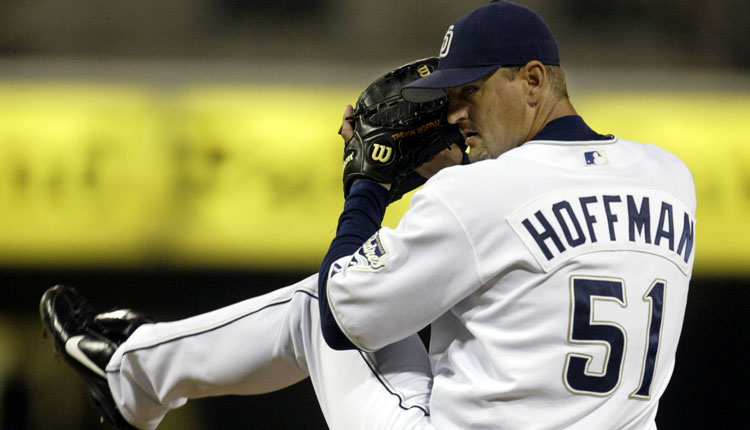Trevor Hoffman: Hall of Fame-Bound or Likely Snub?


*Originally written in early 2016. Updated comments at the end of the post.
As the calendar turns to January, marking the start of a new year, the 2016 Hall of Fame class is coming into clearer focus. With names like Roger Clemens, Ken Griffey Jr., Barry Bonds, Mike Piazza, Jeff Bagwell, and others filling the ballot, there is no shortage of names to select from this year.
While most years have at least one candidate who seems to be a shoo-in, this year that seems to be Griffey, this year has more deserving candidates than in years past, making picking only ten players on each ballot quite a task. As the January 6th deadline draws near, the Hall of Fame cases of every player eligible is scrutinized further than ever before. One person who may be overlooked on this year’s ballot is San Diego Padres’ Hall of Famer Trevor Hoffman.
Hoffman, having played in San Diego for the majority of his career, is dwarfed in terms of star power by the likes of Griffey, Clemens, Bonds, Bagwell, and even fellow reliever Billy Wagner. Despite this, Hoffman still has a strong case to be elected to the Hall of Fame. Even so, does Trevor Hoffman deserve to be elected to the Hall of Fame this year, or in the future? To better understand Hoffman’s case, his career numbers must be further critiqued.
To begin with, the stats that everyone knows. An 18-year career. Seven-time All-Star. Two second place Cy Young finishes. 1,035 appearances. 601 saves (At one time the all-time saves leader before being passed by Mariano Rivera). 2.87 career ERA. 1,133 strikeouts. These are the old school numbers that we are used to seeing when talking about Hoffman. Based on these numbers alone, it is pretty clear that Hoffman is one of the greatest closers of all time, perhaps only behind the great Mariano Rivera.
However, Hoffman’s Hall of Fame case is more complicated than these simple measures show. To better understand his potential Hall of Fame credentials, a deeper dive into more advanced statistics is necessary.
A simplistic way to look at a player’s Hall of Fame credentials is using the Hall of Fame monitor created by Bill James, which attempts to add up all a player’s accomplishments in one score to measure how likely a player is to reach the Hall of Fame. It isn’t a be-all and end-all measurement, but it is useful in its simplicity. By this standard, 100 means a player has a good chance of making the Hall while 130 makes the player a “virtual cinch”, according to the description on Baseball Reference. The rules for points are as follows:
Pitching Rules
15 points for each season of 30 or more wins, 10 for 25 wins, 8 for 23 wins, 6 for 20 wins, 4 for 18 wins, and 2 for 15 wins.
6 points for 300 strikeouts, 3 points for 250 SO, or 2 points for 200 or more strikeouts.
2 points for each season with 14 or more wins and a .700 winning percentage.
4 points for a sub-2.00 ERA, 1 point if under 3.00, in seasons in which surpassed 150 innings pitched.
7 points for 40 or more saves, 4 points for 30 or more, and 1 point for 20 or more.
8 points for each MVP award, 5 for a Cy Young award, 3 for each AllStar Game, and 1 point for a Rookie of the Year award.
1 point for a gold glove.
1 point for each no-hitter. This is not currently included.
2 points for leading the league in ERA, 1 for leading in games, wins, innings, W-L%, SO, SV or SHO. Half point for leading in CG.
35 points for 300 or more wins, 25 for 275, 20 for 250, 15 for 225, 10 for 200, 8 for 174 and 5 for 150 wins.
8 points for a career W-L% over .625, 5 points for over .600, 3 points for over .575, and 1 point for over .550, min. 190 decisions.
10 points for a career ERA under 3.00, min 190 decisions.
20 points for 300 career saves and 10 points for 200 career saves.
30 points for 1000 career games, 20 for 850 games and 10 for 700 games.
20 points for more than 4,000 strikeouts, and 10 for 3,000 SO.
2 points for each WS start, 1 point for each relief appearance, and 2 for a win.
1 point for each LCS or LDS win.
For comparison, the highest pitcher by this measurement is Christy Mathewson with a score of 394. Of the top 25 pitchers by this metric, only two are not in the Hall of Fame, with the two being Mariano Rivera, who is not yet eligible, and Roger Clemens, who should probably already be in. Beyond that, you find only a few other players who are not in the Hall of Fame in the top 40, including Curt Schilling and Clayton Kershaw, who is obviously not eligible. However, interestingly enough, Trevor Hoffman sits at number 41 on the list with an impressive line of Hall of Famers behind him. Like I said before, this isn’t the only stat to look at, but it does paint a pretty clear picture of Hoffman’s career accomplishments.
PAGE 2 LINK BELOW
Editorial and Prospect Writer for East Village Times. Twenty-five years young, Patrick has lived in San Diego for his entire life and has been a Padres fan nearly as long. Patrick lives for baseball and is always looking to learn new things about the game he loves through advanced stats.